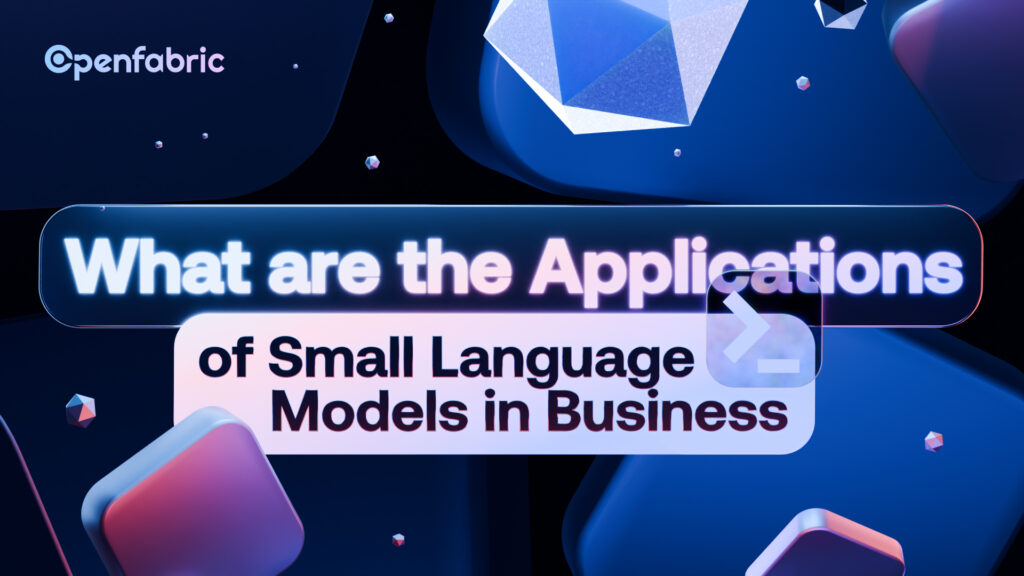
May 16, 2025 6 minutes read
What are the Applications of Small Language Models in Business?

Artificial intelligence (AI) is a fully or semi-autonomous system. To achieve this autonomy, AI systems must be able to reason, predict, and generate human-like responses in a comprehensible language. This need brought about the development of language models. Initially, the AI systems did not need to work on large parameters; as such, small language AI models were sufficient. However, as the need for better working models arose, these small models were sorely inadequate. Therefore, the applications of small language models in business and other sectors are reduced.
Nowadays, small language models (SLMs) are starting to gain popularity again due to their efficiency and versatility as compared to their counterparts, large language models (LLMs). They offer versatility in business and have numerous benefits to companies and other business ventures. In this article, we will discuss the various applications of small language models in business an,d along the way, discover what types of businesses are best suited to use SLMs.
Let’s dive in!
What are small language models?
Small language models are a type of natural language processing model (NLP) with fewer parameters. Like all NLP models, they can process, understand, and generate natural human language.
NLP models are mainly divided into SLMs and LLMs. Know their differences.
SLMs are trained on fewer parameters, usually in the millions instead of billions like LLMs. Initially, this seemed like a disadvantage since more parameters meant better accuracy, but soon enough, end users realized that while LLMs succeeded where SLMs did not excel, there were also some advantages of SLMs. For instance, their design makes them more efficient and easy to scale.
In addition, they can be adjusted to perform specific tasks and fine-tune processes to fit the business model better. As a result, they are perfect for small businesses or start-ups that operate without a confined space.
Advantages of small language models in business
They are easy to train
We already established earlier that SLMs have fewer parameters, especially in comparison with LLMs. Therefore, they can be easily trained to accurately fit any task within the business. For example, because their parameters are fewer, it is fairly easy to train them without requiring extensive technical knowledge.
Cost-effective
The overall cost of training, operating, and maintaining small language models is relatively cheaper than LLMs. That is what makes SLMs ideal for start-ups and small businesses. The cost of infrastructure, personnel for training SLMs, and the maintenance of these language models is optimized to help small businesses save money. With fewer parameters, they are more accessible to companies with limited funding for infrastructure and other IT resources.
Flexible and scalable
SLMs are expandable enough to accommodate the growth of a start-up. Unlike LLMs, SLMs are more flexible and can be continuously optimized as the company grows. Due to its fewer parameters, it can be easily adjusted and fine-tuned to perform more activities as the company expands. However, to get better results from SLMs, it is ideal to know its limits and stay within those limits if they serve the company.
Faster processing
It just makes sense that SLMs process information faster. Imagine sorting through a thousand files versus sorting through a hundred files. As long as the information you are looking for is present in both files, you are more likely to find the document faster among a hundred files. This working principle is similar to how SLMs work. They have fewer parameters to work with, and as such, information processing is faster in SLMs.
In addition, the lightweight nature of having fewer parameters implies that they require less computational power to operate, making them work efficiently.
They are highly compatible
Most small companies and companies work on smaller computational devices. Since SLMs don’t require high computational power, they are highly compatible with these devices.
SLMs are also referred to as narrow-focused models as they carry out only basic functions and have a smaller context window. Therefore, their performance is limited but ideal for small companies to help them save costs and scale easily.
Applications of small language models in business in 2025
Small businesses or start-ups with limited funding can leverage the abilities of SLMs. They have various applications in companies across various sectors. These applications include:
Marketing automation
Marketing is the backbone on which the success of every business rests. However, marketing techniques and strategies have drastically changed in recent times. Technology has brought about great change, and as such, every business owner must employ strategies to keep them a step ahead of their competition. One of such strategies is the use of SLMs in automating marketing.
One way SLMs help in the automation of marketing is the generating content for marketing. Companies can use small language models for product descriptions, video scripts for video advertising, and email campaigns. However, it doesn’t end there.
Automated content generation allows for the quick generation of content, keeping your customers engaged at all times. As such, there is never an inactive moment with your brand.
Furthermore, delivering personalized and relevant messages based on the customer’s preferences creates a sense of belonging, which highly converts customers.
Monitoring marketing strategies
Small language models don’t just stop at content generation in elevating your marketing game. It also provides real-time monitoring of the marketing campaigns created. By doing so, you know what is working and what is not working. You also know where to make necessary adjustments to improve your existing strategies. Essentially, SLMs show you how and where to optimize the marketing strategies you have created for the best results.
Customer service
This is where chatbots with small language models come in. Since small language models are perfect for fast response, they are typically used to improve customer service. For instance, when a customer has a query to make, all they need to do is input the query, and in milliseconds, they have their response. The use of chatbots has significantly improved customer service by automating responses and providing quick support.
More so, with these tools, providing support to customers is not just a daytime job. It operates 24/7, providing uninterrupted assistance and customer service, regardless of your working hours. It is always active.
In addition, automating a routine task such as customer support gives you and your team more time to focus on other areas of the company that require more human involvement. This helps increase the overall efficiency of the company.
Sentiment analysis
You have made your product or delivered services and implemented a well-optimized strategy, and you think, “What is next?” The next thing is to perform a sentiment analysis on the performance of your product in the market, and customer reviews on social media and other platforms. Small language models can be used for sentiment analysis. It helps companies understand the needs of their customers and tailor the improvements to these products according to what these needs are.
In addition to customers’ preferences, it can also provide valuable marketing insights, such as market trends, which can be used to further optimize the products to better serve the customers.
Conclusion
Small language models are often looked down on because they have fewer parameters. However, this is what gives them the advantage they have over other language models, particularly LLMs. The truth is every language models have where they are best suited and functions they are best suited for. For small businesses or start-ups, SLMs are the ideal NLP models that will help save costs and help scale the company. Their advantages make them a valuable AI tool for innovators looking to grow and excel in the technology space, especially where the application of AI is vast.

